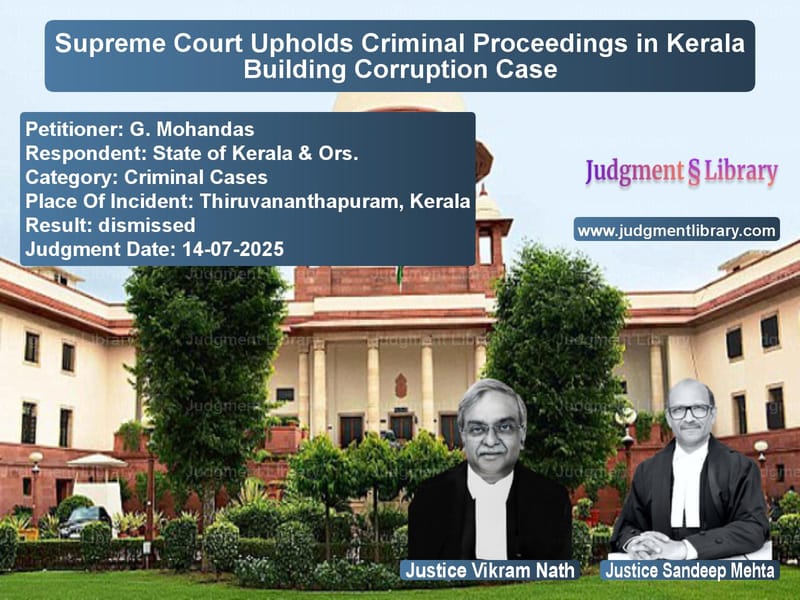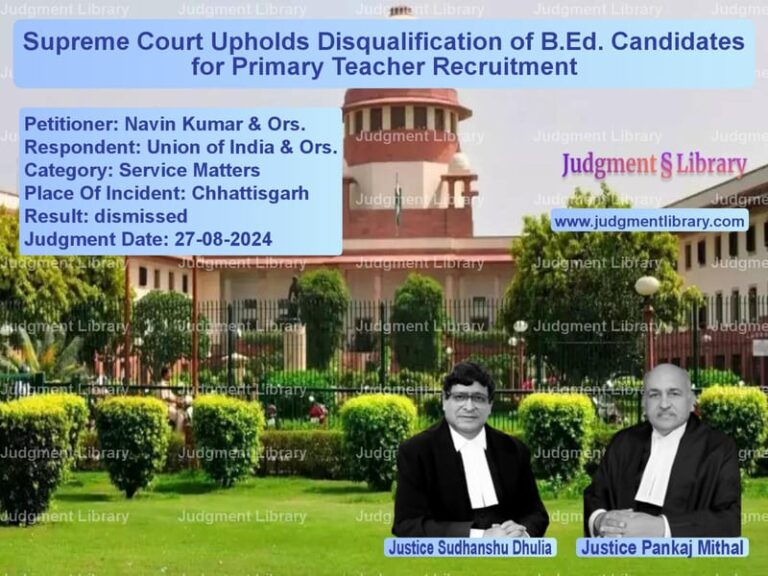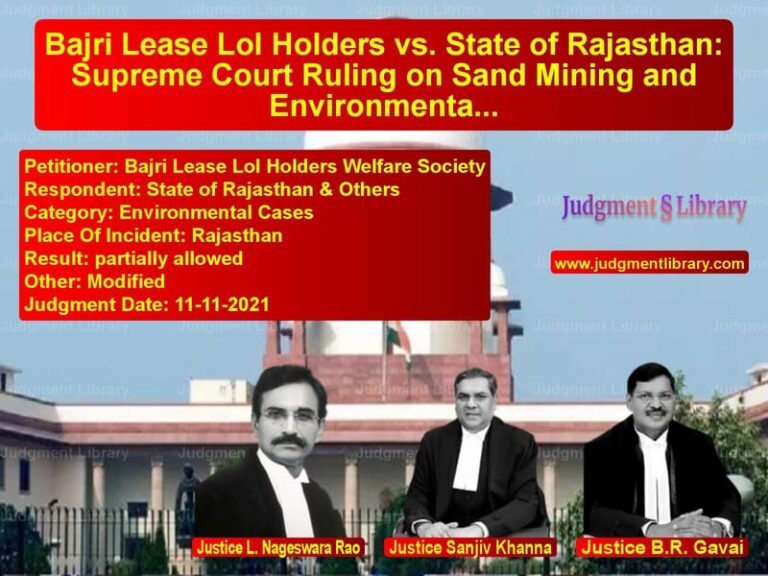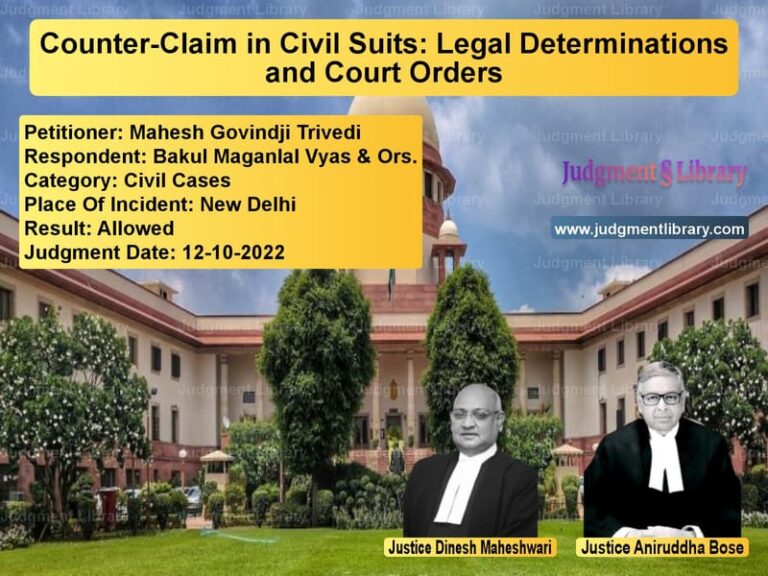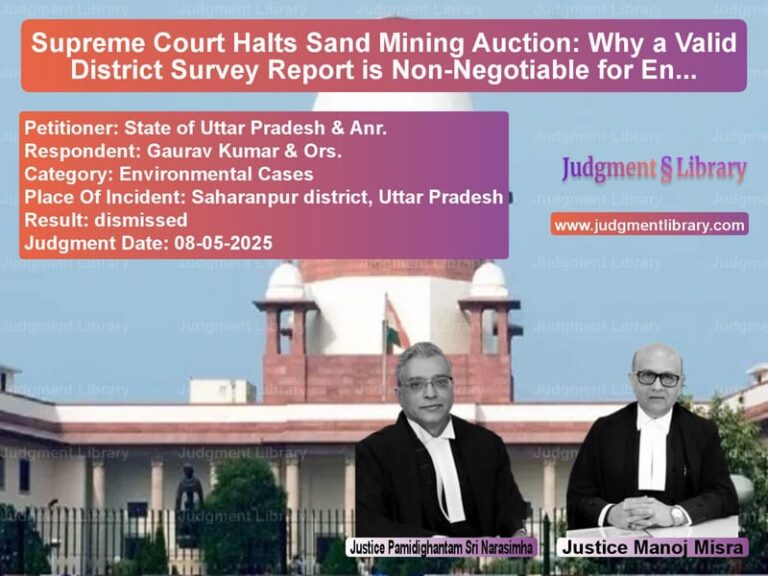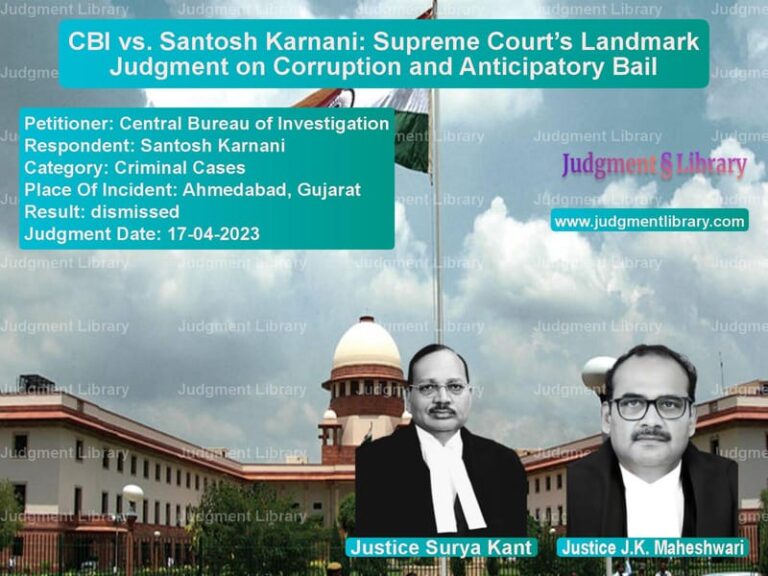Supreme Court Upholds Criminal Proceedings in Kerala Building Corruption Case
In a significant judgment that reinforces the seriousness of corruption in building regulations, the Supreme Court of India has dismissed an appeal seeking to quash criminal proceedings against a building owner accused of conspiring with municipal officials to construct a commercial building in a prohibited zone. The case of G. Mohandas versus State of Kerala & Ors., decided on July 15, 2025, involves serious allegations of criminal conspiracy, corruption, and violation of building rules in Thiruvananthapuram, Kerala. The legal battle began when the appellant, G. Mohandas, approached the Supreme Court challenging the Kerala High Court’s order that refused to quash the FIR and subsequent criminal proceedings against him. The case reveals a complex web of alleged conspiracy between private individuals and government officials to circumvent building regulations for commercial gain.
The dispute centers around a building bearing No. T.C No. 28/1830 in Survey No. 709 of Vanchiyoor Village, Thiruvananthapuram District. The prosecution alleged that Mohandas, in criminal conspiracy with officials of the Thiruvananthapuram Municipal Corporation and an architect, constructed a four-storeyed commercial building by demolishing an existing structure without obtaining necessary permissions. What makes the case particularly serious is that the construction occurred in a zone where commercial buildings were strictly prohibited, and the accused allegedly used a facade of renovation permissions to mask their illegal activities.
The case came to light through a complaint filed by businessman Dr. Biju Ramesh to the Municipal Corporation Secretary, alleging that the appellant had constructed the commercial building in violation of rules through conspiracy with municipal officials. Following this complaint, the Vigilance and Anti-Corruption Bureau conducted a surprise inspection on January 5, 2007, which led to a full-scale vigilance enquiry. The investigation concluded that the appellant and municipal officials had conspired to facilitate the illegal construction, leading to the registration of FIR VC No. 3 of 2009 on March 19, 2009, under Section 13(1)(d) read with Section 13(2) of the Prevention of Corruption Act, 1988, and Section 120-B of the Indian Penal Code, 1860.
The Appellant’s Arguments for Quashing Proceedings
Before the Supreme Court, Senior Counsel Shri R. Basant, representing the appellant, presented several arguments seeking quashing of the criminal proceedings. The appellant contended that the prosecution case did not disclose the necessary ingredients of the offences alleged against him. One of the key arguments advanced was that since the Municipal Corporation had decided to compound the disputed construction by demanding Rs. 18,58,653/- for regularization, the criminality of the alleged act was erased. The appellant claimed that he had sought permission for renovation, alterations, and internal changes to the existing building in a bona fide manner, but heavy rainfall caused the building to collapse, compelling him to construct a new building.
Shri Basant further argued that the architect for the building, A. Dharamakeerthi (accused No. 7), had successfully obtained quashing of proceedings against him from the High Court, and therefore, the appellant deserved similar treatment on grounds of parity. The appellant urged that there was no violation of rules in raising the new construction, especially since the application for regularization had been accepted. Based on these arguments, the appellant’s counsel strongly contended that “the appeal is fit to be accepted and the impugned order passed by the High Court, along with all the proceedings sought to be taken against the appellant, deserve to be quashed.”
The State’s Counter-Arguments
Senior Counsel Shri P.V. Dinesh, appearing for the respondent-State, vehemently opposed the appellant’s submissions. The State argued that the appellant’s claim about the building collapsing due to torrential rainfall was “nothing but a figment of imagination.” The prosecution revealed that after receiving complaints about illegal construction, the Vigilance Department had issued a stop memo to the appellant on November 27, 2006. Despite this official prohibition, the appellant continued the construction in sheer defiance of the stop memo and raised a four-storey commercial building in a prohibited zone.
The State further contended that the appellant tried to cover up his fraudulent acts by filing an ex-post facto application for regularization, even though no such regularization was permissible since the building was constructed in a non-commercial zone. Importantly, the State pointed out that “the regularisation never took place, as the criminal acts of the appellant and the officials had already been exposed during the vigilance enquiry.” The State also informed the Court that after the High Court dismissed the appellant’s petition, the Special Judge had already directed framing of charges against the appellant, making the current appeal without valid grounds.
The Supreme Court’s Analysis and Reasoning
The Supreme Court, after hearing both parties and examining the material on record, delivered a comprehensive judgment dismissing the appeal. The Court made several crucial observations that highlighted the seriousness of the alleged offences. The Bench noted that “it was not disputed and is also evident from the Kerala Municipality Building Rules, 1999, that there is no requirement whatsoever for seeking permission to make alterations, renovations, or internal changes in an existing building.” Despite this clear legal position, the appellant acted in conspiracy with municipal officials to procure such permission, which the Court described as “a precursor to the fraudulent design of raising construction of a commercial structure in a prohibited zone under the garb of the renovation permission.”
The Court observed that “from the very beginning, the appellant acted in conspiracy with the Municipal Corporation officials by giving a facade of legitimacy to his fraudulent actions and to establish a pre-emptive defence in case the illegal acts were exposed.” This finding was particularly significant as it demonstrated the calculated nature of the alleged conspiracy. The Court further noted the appellant’s defiance of the stop memo issued by the Vigilance Department, emphasizing that “in sheer defiance of the stop memo, a four-storeyed commercial building was constructed.”
The judgment extensively analyzed the sequence of events and concluded that “the appellant and the officials of the Municipal Corporation were acting hands in glove right from the time of granting permission to renovate the pre-existing building.” The Court found that municipal officials deliberately turned a blind eye to the fact that the appellant had commenced construction of a commercial structure by misusing the permit granted for renovations. The officials even entertained the fraudulent application for regularization of the patently illegal structure, despite the construction being in a prohibited zone where such regularization was impermissible.
Distinction from the Architect’s Case
The Court specifically addressed the appellant’s argument regarding parity with the architect (accused No. 7), whose prosecution had been quashed by the High Court. The Bench made a clear distinction, stating that “the case of the architect, whose prosecution was quashed by the High Court, stands on an entirely different footing. He was merely discharging his professional obligations while preparing the architectural design for the building, without any active involvement in the alleged conspiracy or the execution of the illegal construction.”
The Court emphasized that “there is no material on record to suggest his prior knowledge or participation in the criminal intent shared by the appellant and the Corporation officials.” Therefore, the appellant could not claim parity with the architect, and any reliance on the order quashing proceedings against him was “wholly misplaced.” This distinction underscored the different levels of involvement and criminal intent among the various accused persons.
The Court’s Final Ruling and Directions
In its concluding remarks, the Supreme Court expressed its “firm opinion that the impugned order dated 16th January, 2024, passed by the High Court of Kerala in Criminal Miscellaneous Case No. 330 of 2021, does not suffer from any infirmity whatsoever so as to warrant interference by this Court.” The appeal was consequently dismissed as being devoid of merit.
The Court also issued an important direction to the concerned authorities, stating that “the concerned authorities shall be under an obligation to take suitable action against the illegal construction raised by the appellant, uninfluenced by any extraneous circumstances.” This direction ensures that the illegal construction does not get regularized through backdoor means and that appropriate action is taken in accordance with law.
The judgment serves as a strong reminder that attempts to circumvent building regulations through conspiracy with public officials will not be tolerated by the judiciary. The Court’s refusal to quash the proceedings at the threshold stage ensures that the trial court will have the opportunity to examine the evidence thoroughly and deliver justice in accordance with law. This case reinforces the principle that corruption in urban development and building regulations constitutes a serious offence that undermines public interest and urban planning norms.
Petitioner Name: G. Mohandas.Respondent Name: State of Kerala & Ors..Judgment By: Justice Vikram Nath, Justice Sandeep Mehta.Place Of Incident: Thiruvananthapuram, Kerala.Judgment Date: 14-07-2025.Result: dismissed.
Don’t miss out on the full details! Download the complete judgment in PDF format below and gain valuable insights instantly!
Download Judgment: g.-mohandas-vs-state-of-kerala-&-or-supreme-court-of-india-judgment-dated-14-07-2025.pdf
Directly Download Judgment: Directly download this Judgment
See all petitions in Fraud and Forgery
See all petitions in Money Laundering Cases
See all petitions in Property Disputes
See all petitions in Public Sector Employees
See all petitions in Corporate Compliance
See all petitions in Judgment by Vikram Nath
See all petitions in Judgment by Sandeep Mehta
See all petitions in dismissed
See all petitions in supreme court of India judgments July 2025
See all petitions in 2025 judgments
See all posts in Criminal Cases Category
See all allowed petitions in Criminal Cases Category
See all Dismissed petitions in Criminal Cases Category
See all partially allowed petitions in Criminal Cases Category

